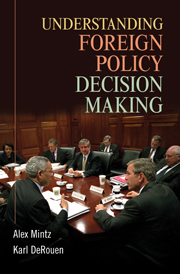Book contents
- Frontmatter
- Contents
- Acknowledgments
- PART ONE INTRODUCTION
- PART TWO THE DECISION ENVIRONMENT
- PART THREE MODELS OF DECISION MAKING
- PART FOUR DETERMINANTS OF FOREIGN POLICY DECISION MAKING
- 6 Psychological Factors Affecting Foreign Policy Decisions
- 7 International, Domestic, and Cultural Factors Influencing Foreign Policy Decision Making
- PART FIVE MARKETING FOREIGN POLICY
- PART SIX CONCLUSION
- Appendix: Foreign Policy Simulation and Exercise
- References
- Index
7 - International, Domestic, and Cultural Factors Influencing Foreign Policy Decision Making
Published online by Cambridge University Press: 05 June 2012
- Frontmatter
- Contents
- Acknowledgments
- PART ONE INTRODUCTION
- PART TWO THE DECISION ENVIRONMENT
- PART THREE MODELS OF DECISION MAKING
- PART FOUR DETERMINANTS OF FOREIGN POLICY DECISION MAKING
- 6 Psychological Factors Affecting Foreign Policy Decisions
- 7 International, Domestic, and Cultural Factors Influencing Foreign Policy Decision Making
- PART FIVE MARKETING FOREIGN POLICY
- PART SIX CONCLUSION
- Appendix: Foreign Policy Simulation and Exercise
- References
- Index
Summary
INTERNATIONAL FACTORS
Foreign policy decisions are typically made in a strategic setting. Thus, behavior of adversaries and allies affects foreign policy decisions in an interactive sequential setting. For example, U.S. foreign policy during the Georgian crisis in the summer of 2008 was implemented in response to Russia's actions in Georgia. U.S. policy on missile defense in Europe affects Russia's decisions as well as Polish, Czech, and other European leaders' decisions. U.S. foreign policy goals and actions influence Israeli policies toward its enemies and friends. Factors such as the arms race, deterrence, the regime type of the adversary, strategic surprise, and of course alliances affect foreign policy decisions (see Table 7.1).
For example, it was empirically demonstrated that leaders of democratic states are much more likely to attack a nondemocratic adversary than they are another democracy. It is also clear that the mutual assured destruction (MAD) strategy affected superpower behavior during the Cold War and that the arms race between the United States and the USSR and between NATO and the Warsaw Treaty Organization (WTO) influenced many decisions not only of the actors directly involved in the race (the United States and the USSR) but also of third-party players such as China, India, South Korea, Israel, Japan, the Arab states, and, of course, European states. After considering the factors in Table 7.1, we turn to the analysis of domestic factors that shape foreign policy decisions, such as economic conditions (diversionary theory) and the role of public opinion.
- Type
- Chapter
- Information
- Understanding Foreign Policy Decision Making , pp. 121 - 146Publisher: Cambridge University PressPrint publication year: 2010



